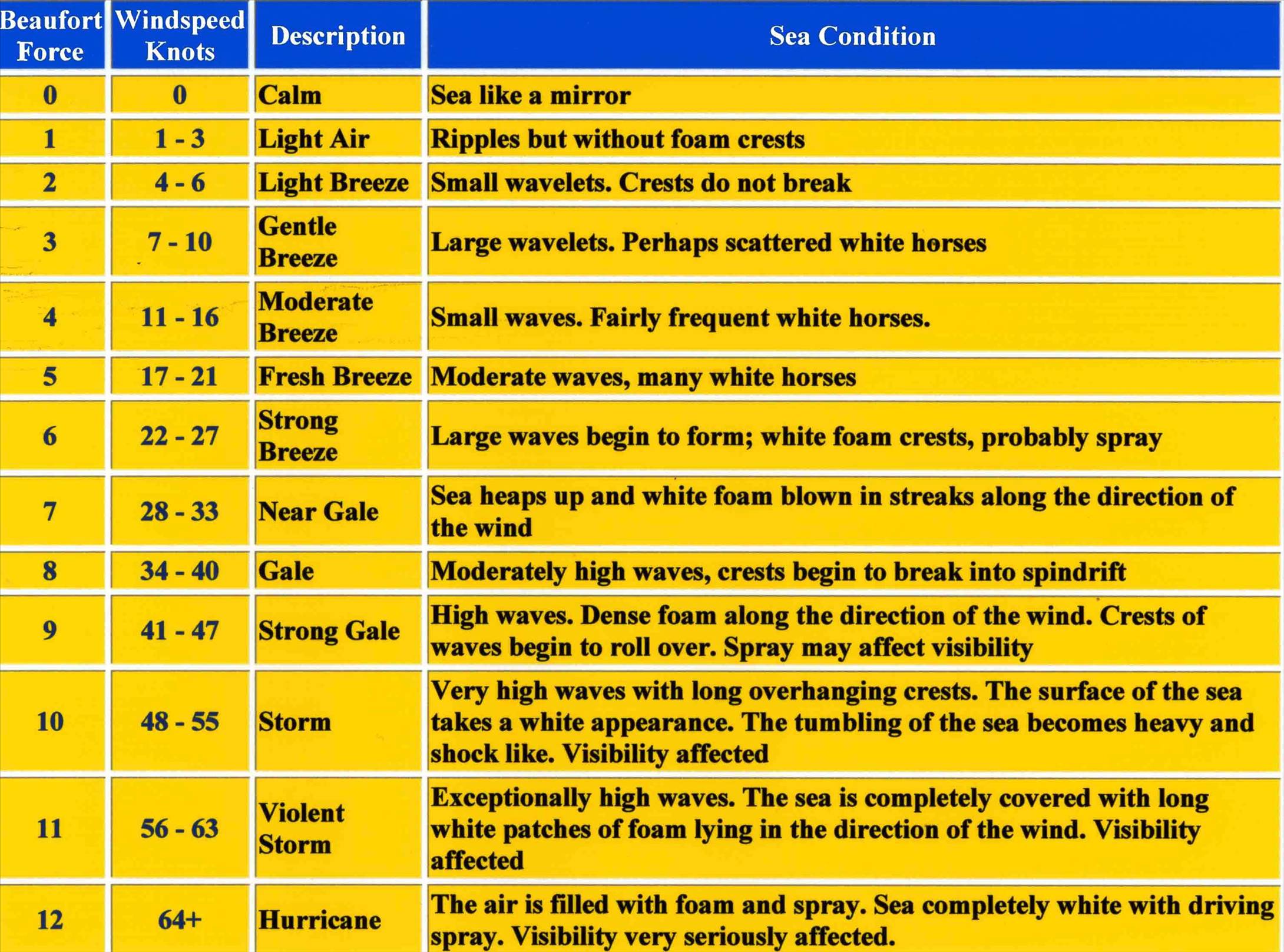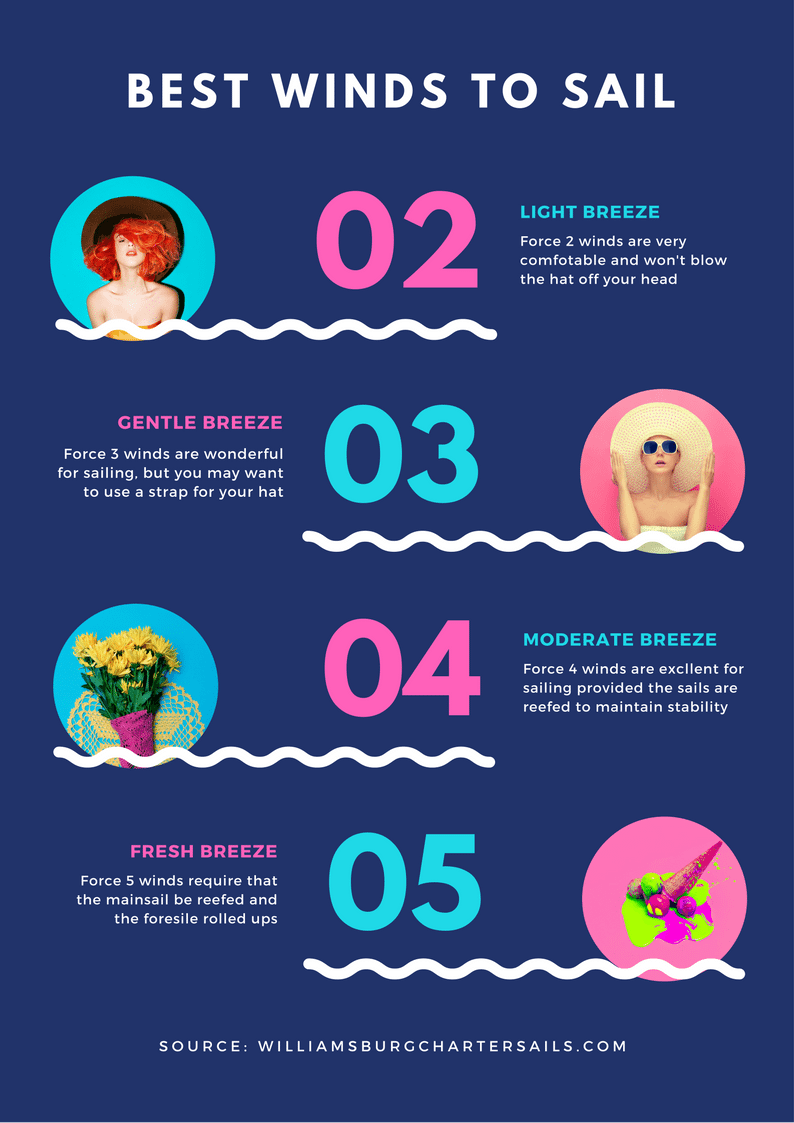
They say you can never be too thin or too rich, but you can have too much wind. That’s why you need to learn the best winds to sail. That in turn leads to bigger waves. Here’s a brief rundown on the Beaufort Wind Scale, from noaa.org.
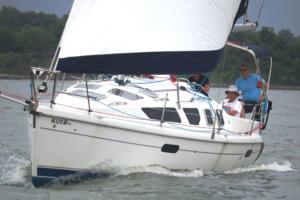 Keep in mind that the published winds are for open water such as the middle of the Chesapeake Bay or the Atlantic Ocean. Certain websites show exact winds at key locations. In our case, the waters of the York River are five miles inland and protected by trees and land mass. That said, an east fetch of a hurricane is just as bad on the York as it is on the Bay because the waves are free to build.
Keep in mind that the published winds are for open water such as the middle of the Chesapeake Bay or the Atlantic Ocean. Certain websites show exact winds at key locations. In our case, the waters of the York River are five miles inland and protected by trees and land mass. That said, an east fetch of a hurricane is just as bad on the York as it is on the Bay because the waves are free to build.
Force 1
This consists of Light Air blowing 1-3 knots with mere ripples on the water. (For the purposes of this blog, a knot is roughly 1 mph.) One can sail easily, albeit slowly. When forecasters talk of winds that are light and variable, this is what they have in mind. Sailboats proceed on an even keel. Guests are surprised get caught up in conversation and the scenery, only to find they have sailed a mile or more without realizing it.
Force 2
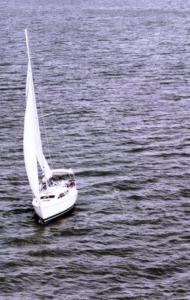 Winds are blowing 4-6 knots, which is good for sailing. This is technically a Light Breeze and creates barely perceptible wave action. By now, guests realize the force of the wind and begin to appreciate its ability to move the boat smartly.
Winds are blowing 4-6 knots, which is good for sailing. This is technically a Light Breeze and creates barely perceptible wave action. By now, guests realize the force of the wind and begin to appreciate its ability to move the boat smartly.
Force 3
Winds are picking up to 7-10 knots in a Gentle Breeze that produces tiny waves and an occasional whitecap. This makes for ideal sailing in a mid-size boat. Heeling gets to 10-15 degrees and speed picks up to 10 mph. People become mesmerized by the magic of sailing like as they take in the wind and ride it magnificently.
Force 4
Now the winds are 11-16 knots in a Moderate Breeze that may require reefing the mainsail and/or the foresail jib or genoa. Waves are 1-4 feet with numerous whitecaps. The range of the waves is from trough to peak. Smaller boats find Force 4 a challenge. For bigger boats like Let’s Go Sail, things get exciting. Heeling is consistent at 15 degrees, and the sails need to be trimmed outward to spill wind. It takes a few minutes to adjust, but guests find the sailing exhilarating.
Force 5
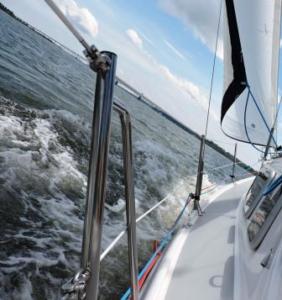 Winds are blowing 17-21 knots in what is euphemistically described as a Fresh Breeze. Waves are elongated and running 4-8 feet, with “some spray.” Spray is nature’s way of telling you the winds are strong. By now a mid-size sailboat will require reefing the main to half and rolling in the jib entirely. Heeling remains 15% as the sails are trimmed outward. Things are equally exhilarating as earlier forces because the reefed sails spill the wind perfectly without diminishing speed.
Winds are blowing 17-21 knots in what is euphemistically described as a Fresh Breeze. Waves are elongated and running 4-8 feet, with “some spray.” Spray is nature’s way of telling you the winds are strong. By now a mid-size sailboat will require reefing the main to half and rolling in the jib entirely. Heeling remains 15% as the sails are trimmed outward. Things are equally exhilarating as earlier forces because the reefed sails spill the wind perfectly without diminishing speed.
Force 6
Now we’re talking winds of 22-27 knots and waves of 8-13 feet, a Strong Breeze indeed. More spray is flying. Only experienced sailors are out in this stuff, and they have to be careful how to take the waves. If a 13-foot wave strikes the side of the boat, it could roll 90 degrees before recovering. Very unpleasant.
Force 7
Winds rise to 28-33 in a Near Gale, with waves 13-19 feet and spray blowing off their tops. These waves would not obtain in the Chesapeake Bay or York River because both are shallow at 25 feet average. Out in the ocean, you’d want to be on a Navy ship.
Force 8-12
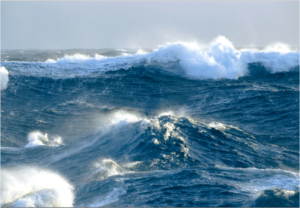 Things get progressively worse until winds build eventually to 64+ knots or 75 mph as a Category 1 Hurricane. Waves in the ocean rise to 45 feet, so in the Ocean you’d want to be on an aircraft carrier. In the York, the waves are much less but the chop is violent. Hurricane Isabel was a Cat 1 hurricane in 2001. York River Yacht Haven shot photos the parking lot showing waves of water, with whitecaps. You do not want to be on a boat in a hurricane. It’s better to be sitting on a barstool, holding a beer for stability.
Things get progressively worse until winds build eventually to 64+ knots or 75 mph as a Category 1 Hurricane. Waves in the ocean rise to 45 feet, so in the Ocean you’d want to be on an aircraft carrier. In the York, the waves are much less but the chop is violent. Hurricane Isabel was a Cat 1 hurricane in 2001. York River Yacht Haven shot photos the parking lot showing waves of water, with whitecaps. You do not want to be on a boat in a hurricane. It’s better to be sitting on a barstool, holding a beer for stability.
Let’s go sail, to feel the wind
Check rates and pick a day for a sailboat charter. See reviews on Trip Advisor from sailors like you.
